Scoutmaster Musings
Archives:
2025 2023 2022 2021 2020 2019 2018 2017 2016 2015 2014 2013
2012 - Dec Nov Oct Sep Aug Jul Jun May Apr Mar Feb Jan
2011 2010 2009 2008 2007 2006 2005
2013 High Adventure Training
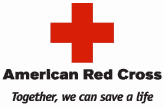
 Philmont, Sea Base, Northern Tier, the Summit - big places with big adventure for scouts! Whether you're going to a national high adventure base or rolling your own exciting adventure, training in Wilderness and Remote First Aid is either required or highly encouraged. Any troop, crew, or pack that goes into the outdoors would benefit from the skills and knowledge found in the WRFA training - not just wilderness backpacking trips.
Philmont, Sea Base, Northern Tier, the Summit - big places with big adventure for scouts! Whether you're going to a national high adventure base or rolling your own exciting adventure, training in Wilderness and Remote First Aid is either required or highly encouraged. Any troop, crew, or pack that goes into the outdoors would benefit from the skills and knowledge found in the WRFA training - not just wilderness backpacking trips.Troops going to the 2013 National Jamboree are not required to have certified WRFA leaders, but Philmont, Sea Base, and Northern Tier all require at least one currently certified person per crew. If you haven't gotten the required training taken care of for next summer, don't wait much longer to arrange it. The Red Cross WRFA training covers a wide range of injuries and ailments, and it's pretty fun - just a long weekend.
I just presented WRFA this past weekend yet again. But, this time, it wasn't for Scouting folks. The University of Minnesota has an Engineers Without Borders chapter and they are going to Uganda in January. They will work to set up a clean water system for the people living there. Since it's such a remote location, they wanted to be a bit prepared first. Some of them are also heading to Guatemala in the spring.
I enjoyed spending my weekend with 10 young engineers and helping them prepare to make life a bit better for strangers on the other side of the world.
Scout On
| Leave Comment |
Posted: 17:34 11-20-2012 932
Scouts Helping Scouts
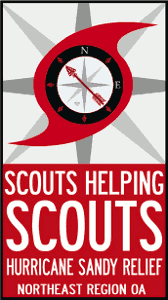
 "No one has ever become poor by giving." - Anne Frank
"No one has ever become poor by giving." - Anne Frank"There is no exercise better for the heart than reaching down and lifting people up." - John Holmes
Hurricane Sandy, and the storm that followed, brought severe damage to people, places, and things across the Northeast Region. In an effort to help, the Leadership Team of the Northeast Region OA has set a goal to raise at least $20,000 that will be awarded to OA Lodges in the Northeast to help complete projects at their council camps to clean up and rebuild after the storm.
The NE Region OA Leadership Team would like folks (that's you) to purchase this patch for $10. 100% of the funds raised goes directly towards helping council camps since the OA paid for production of the patches.
Just fill out this form and send it with a check for a patch, or a dozen patches.
I'm not saying they'd make good Christmas gifts, but presenting them to the newest OA members in your troop at a troop meeting while explaining what they mean might be a pretty good object lesson showing what being in the OA is all about. Hey, it might make a good Scoutmaster Minute.
I've sawed trees and fixed up local council camps quite a few times as an OA member. This is a way to virtually do a little arduous labor to help Scouts far away.
Scout On
| Leave Comment |
Posted: 22:52 11-15-2012 931
10 Winter Service Ideas
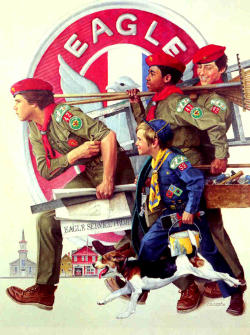
 Eagle projects tend to be about building things outside, and that tends to be done from April through October when it's warmer outside (around here anyway). Providing service to the community can drop off over the winter, but it doesn't need to be that way. There are many potential service opportunities out there, maybe not for Eagle projects, but certainly for scouts to get out in the community and help others.
Eagle projects tend to be about building things outside, and that tends to be done from April through October when it's warmer outside (around here anyway). Providing service to the community can drop off over the winter, but it doesn't need to be that way. There are many potential service opportunities out there, maybe not for Eagle projects, but certainly for scouts to get out in the community and help others.Here's 10 ways scouts can pitch in and lend a hand:
- Spread the Word - Work with the city council, police, or fire department to distribute flyers, magnetic cards, or pamphlets about fire alarm maintenance, christmas fire safety, home energy conservation, organ donor awareness, community contact info (substance abuse, neglect, depression, ...), or whatever the city would like taken door-to-door.
- Ring Dem Bells - Volunteer a few hours ringing Salvation Army bells outside businesses.
- Toys 4 Tots - organize a toy drive, volunteer at a collection site, or help in a warehouse. Or, organize a toy/book/clothing drive after Thanksgiving to make room for all that new Christmas stuff that will fill closets again.
- Welcome Home - College students often have early January off. Plan your first troop meeting of the year to be an alumni party and invite past scouts.
- Shelter Support - Serve meals at community shelters. Draw and color placemats for shelters to use at Thanksgiving and Christmas meals. Clean shelters after especially busy times.
- Serve Seniors - Arrange a visit to a senior citizens home. Play games, sing songs, visit, write letters for them. Assist elderly with their holiday shopping by carrying packages, helping on/off bus, wrapping packages.
- Be Thankful - Write letters to soldiers away from home thanking them for their efforts. Write thank you cards to local fire, police, emergency, and mayor departments letting them know they are appreciated. Bake treats for fire and police units in January, the coldest month.
- Cheer for Children - Visit children in hospitals. Make simple wooden toys for local shelters to give to children. Set aside a December weekend when parents can drop off their kids for free babysitting while they do their holiday shopping.
- Free Fire Hydrants - After snowfalls, dig out fire hydrants in your neighborhood. Ask the resident whose property it is on if it's OK before you start. Many people will want to give money, but don't take it.
- Recycle Christmas - Give cards to Christmas tree lots to hand out with each tree that says the date and location to bring the tree for free recycling. Include an email to send request to have the tree picked up instead on that date for a fee. Could sell bags of wood chips or mulch at the recycling spot.
Plus a couple more:
- Plan Ahead - Make wooden houses or feeders for bats, ducks, owls, birds, butterflies, or squirrels to be installed in spring in local parks, nature areas, or residences.
- Welcome Wagon - Arrange with school principal to tell you when a family with students is moving into the area. Scouts about the same age call and visit the family to welcome them, and then watch out for that student at school.
Got any more to add to the list?
| Leave Comment |
Posted: 9:45 11-15-2012 930
Boy Scout Recruiting
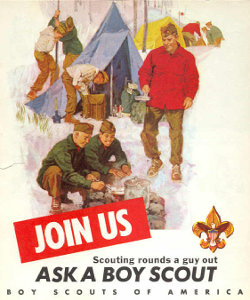
 In three months, most Cub Scout Packs will have their Blue Gold dinners and cross Webelos over into Boy Scout troops. If your troop is hoping some of them will join you, you've already missed the boat!
In three months, most Cub Scout Packs will have their Blue Gold dinners and cross Webelos over into Boy Scout troops. If your troop is hoping some of them will join you, you've already missed the boat!Waiting and hoping aren't going to keep your troop vibrant, strong, and healthy. Actively engaging Webelos now before they make their troop decision is what you need to do. There are tons of ways to get Webelos interested in your troop but, before I share my list, you should decide how many new scouts your troop needs. Now, don't be greedy!
If there are other troops in your community, communication with those scoutmasters and committee chairs is a good idea. Rather than being secretive and competitive, it really can work to be cooperative and figure out what's best for the troops and the scouts.
How many new scouts does each troop need? A troop of 20 scouts that gets 10 new scouts may lose many of them because of being ill-prepared for the influx. A troop of 70 scouts doesn't need 20 more scouts. If every troop got one 9-member patrol each year, that would be around 50 scouts total in the troop. A troop growing much larger than that should consider seeding a new troop to spread their success.
I realize that every troop is different. The way the scoutmaster interprets scout-led and the rest of the BSA program has a huge impact on the health of the troop. When a troop has leaders that promote or allow activities and behaviors against the aims and ideals of Scouting, that troop will struggle to attract and retain new scouts.

 Assuming your troop is running well and you would like to bring in a bunch of new scouts this year, here's some good ideas to consider:
Assuming your troop is running well and you would like to bring in a bunch of new scouts this year, here's some good ideas to consider: - First Fish - if one Webelos knows he's joining your troop, ask him to let his den know where he's going. This might be a younger brother of one of your scouts, or your neighbor, or a kid from church. Many scouts just follow where it seems the others are going.
- Super Scouts - offer two eagle scouts to visit a fall Webelos den meeting to answer questions about Boy Scouting and tell about some of their adventures. Uniforms, sashes, and high adventure patches are very cool to wear.
- Collaborate - contact the Webelos den leaders and ask how your troop can help his/her Webelos finish their Arrow of Light requirements. Make sure they know your troop meetings are open to them.
- Scout Skills - schedule two recruiting events in the fall. A day of your scouts' favorite games and stations for Webelos to practice first aid, fire, knots, and the like works great. A hike can be fun and fulfills an Arrow of Light requirement.
- Pinewood Partners - offer to have scouts help at the Pack's Pinewood Derby - shuttling cars, keeping people away from the track, serving snacks, whatever is needed.
- Double Trouble - challenge each Webelos scout that says he's joining your troop to ask a non-scouting friend to check out the troop. He can get a Recruiter strip right away.
Looking ahead to next year, recruiting should be a year-round activity. This takes more planning as part of your normal program.
- Den Chiefs - having a scout help lead a den of 5th grade Webelos has a big impact on if, and where, they continue their Scouting trail. A First Class scout can be a den chief from Sept through Feb and then become a Troop Guide for that new patrol of scouts to help them succeed.
- Rubbing Shoulders - attend roundtable meetings and seek out Pack leaders. Let them know what exciting things the troop's been doing and ask if they need any help.
- Prepare and Plan - by May, have a plan and schedule of your fall Webelos recruiting activities. Hand it to all the Webelos den leaders.
- Camporee Cohorts - invite Webelos dens to join your troop at the district camporees. They're a perfect way to see Boy Scout camping in your troop.
- Troop Expo - plan an open evening for all Webelos and their parents to check out all the local troops. Each troop has a table showing off their adventures set up in a gym or church for a couple hours.
If you focus exclusively on Webelos scouts to keep your troop roster full, you're missing out on a huge potential pool of scouts. By viewing the transition from Webelos to Boy Scouts as a completely new experience, it becomes the perfect time for other 5th graders to join Scouting.
As a troop leader, you could do a Boy Scout presentation at local schools, if you're welcome. But, really the best recruiting tool is your existing scouts. Convincing them that their efforts to add another scout are important to the health of the troop might be your challenge. Some ways to help motivate them to invite a friend:
- Patches - use the Recruiter strip, that's what it's for. Other fun patches are inexpensive.
- Advancement - have new scouts complete the First Class 'tell a friend' requirement right away while there's a better chance of having that friend join. A boy that was busy in the fall might join his friend having fun in the spring.
- Buddy Bowling - plan a non-camping activity that only scouts with a friend can attend, such as bowling, swimming, mini-golf, anything BSA-approved that they want.
- Free Fun - have a campout that is free for any scout that brings a friend.
A few other tidbits that might help your recruiting efforts:
- Teams - remind your sports-oriented scouts that they should ask their teammates to give Scouting a try at the end of their season.
- Trinkets - give out stuff so visitors remember which troop you are, such as wooden nickels, bookmarks, pencils, business cards, pins, or patches.
- Tag-ons - provide postcards in every fundraiser order that asks the buyer to pass it on to neighbors with a 5th or 6th grade boy. It invites him to join and has your contact info.
- Twofers - don't limit your Webelos recruiting events to just Webelos. Invite all 5th and 6th grade boys to your scout skills day, lock-in, or whatever you do.

Well, after all that, I should tell you that in my time as a scoutmaster we didn't recruit for our troop. Our focus was completely on convincing the Webelos scouts that their Arrow of Light was just the beginning of 'real' scouting. They needed to continue scouting somewhere.
Our troop does many of the activities listed above, but never puts down the other four local troops and doesn't tell Webelos to join our troop. Scouts can say they are always welcome, but they should check out the options and choose which one is best for them. That's exactly what we adults tell the parents, too.
And, that might just be the best recruiting tip there is.
Scout On
| Leave Comment |
Posted: 17:34 11-13-2012 929
Scout Summer Jobs
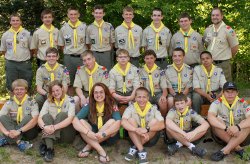
Yeah, yeah, I know it's not even Thanksgiving yet, but it's not too early to think about work for next summer. Camps and other great places to work need to line up their staff over the winter and that means scouts need to get their applications in soon.
Now's a good time to tell those mature scouts in your troop to get started.
The BSA has over 400 scout camps, 60 council high adventure programs, and 4 national high adventure bases. Many of the 900,000 Boy Scouts will spend a week next summer at one of those places, but only a few will spend their entire summer there - and get paid to do it! Why spend a summer working with the Boy Scouts? Well, there's plenty of reasons:
- Become friends with other scouts from around the country, even other countries
- Lots of camping nights to use for your National awards
- Tons of teamwork, both leading and following
- Hone and expand your outdoors skills
- Become a better teacher, leader, and friend
- Assist young scouts on their trail of becoming young men
- Live, work, and breathe Scouting in an environment focused on Scouting
- Learn from experienced senior staff with the same values as you
- Receive food, lodging, and pay for work well done
- Take on greater responsibilities as you prove your abilities
- Start a record of strong work ethic for future jobs
- You don't have to make change for a $20
- Your clothes and hair don't smell like french fry oil
- The uniform doesn't have a big M, DQ, or BK on it
Here are a few camps for example, but you can contact your council to find out what employment opportunities are near you.
- Camp Many Point - Northern Star Council
- Camp Cedars Mid-America Council
- Cascade Pacific Council
- Shawnee Trail Council
- Patriots Path COuncil
- Crossroads of America Council
- Capitol Area Council
- Philmont
- Sea Base
- Northern Tier
Scout On
| Leave Comment |
Posted: 15:19 11-12-2012 928
Campfire Safety

There were a few small fires in the Bighorn Mountains of Wyoming this past week. Fire managers believe they were caused by untended campfires. Fortunately, they only burned less than 100 acres. Not a big deal.
Last year, a wildfire in Arizona burned over 840 square miles. It was the result of two young men leaving their campfire without completely extinguishing it. They were just ordered to pay $3.7million dollars - this is only a small fraction of the $73 million spent battling the wildfire.
I don't know about you, but I sure couldn't afford that if I had some scouts out and we left our campfire to run wild.
Even though the weather is cooling off, fire danger is still high until rains and snow dampen the forests, so this advice may be relevant for those of you heading out camping tonight.
Along with the fun of a campfire, comes great responsibility. Besides being skilled at starting a fire undewater with just two sticks, a good outdoorsman will prepare his fire site, use appropriate fuel, maintain safety around the fire, and guarantee the fire is out cold before leaving it. All you should need to have a fire is a match, a knife, and a water bucket.
Preparing the Site:
The best rule of thumb is to only have a fire in an established fire ring. By doing this, no further impact to the land will be made and the fire will be easier to contain. If you make a fire outside an established ring, there is no real need to gather rocks and create a ring. Just build the fire on a suitable spot. Guidelines for a suitable spot are:
- Choose a spot 15 feet away from trees and brush which may have shallow roots under the fire.
- Have your fire downwind from your tent and gear.
- Clear all flammable material from the ground for 5 feet around the fire.
- Ensure no branches are hanging above the fire. Only have a fire where there is plenty of available wood to burn.
- If the weather is very dry and/or windy, have a fire some other day.
Use Appropriate Fuel:
Tinder, kindling, and fuel get the fire going, build it up, and then maintain its life. The choices you make for fuel can help reduce impact and make a better fire.
- Find dry wood under trees, more likely on the southeast side.
- Leaning sticks are usually more dry and solid than sticks flat on the ground.
- Use pine needles, pinecones, and grass rather than leafs for tinder.
- Split sticks or shave off bark with a knife to expose dry inner wood.
- A stick split in fourths has more points and edges to catch fire than a full round stick, especially one with bark still on it.
- Leave dead wood still attached to a tree, just take what's on the ground.
- Soft or very light wood is rotting and won't burn well, even if dry.
- Choose wood you don't need an axe to chop or split - usually smaller than your wrist can be broken by hand or foot.
- Trash is not fuel - pack it out instead.
- Stack your wood upwind and at least 5 feet from your fire.
Maintain Safety:
Fire is the most dangerous thing man brings into the wilds. It is dangerous to forests, animals, and humans. To be safe:
- Have plenty of water ready to put it out even before lighting the fire.
- Keep activities away from the fire.
- Keep the fire to a small, manageable size.
- Ensure someone is always responsible for watching the fire.
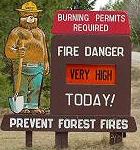 Extinguishing the Fire:
Extinguishing the Fire:Every year, there are stories of I thought it was out. It's simple to kill a fire and there's no excuse for not guaranteeing your fire will burn no more forever.
- Start extinguishing your fire at least a half hour before you plan to leave.
- Burn wood completely to grey ash. Using smaller pieces of wood helps.
- Sprinkle water on the fire, being careful of the steam.
- Continue to add water, drowning all coals, not just the red ones
- Stir campfire ashes and embers with a shovel, stick, or stake
- Scrape sticks and logs to remove any hot embers
- Let the fire sit for 10 minutes.
- Stir and make sure everything is wet and cold to the touch
- Hover your hand low over the fire, feeling for warm spots. Break up and re-douse any you find until there are none.
- If you do not have water, you should not have a fire. Just burying a fire does no good - it can burn for days and spring back to life.
In some areas, you should clean the ash and coals from the firepit and disperse them far off in the woods. Other places prefer you leave the ash in the firepit, or deposit it in a can. Find out before you go which is suggested.
If it's too hot to touch, it's too hot to leave!
| Leave Comment |
Posted: 13:04 11-09-2012 926
VOTE

Fitness, Character, and Citizenship - today is a great opportunity to emphasize the rights and responsibilities of being a citizen. Since citizenship is one of the three aims of Scouting, and there are three Eagle-required citizenship merit badges, do your part and be a role model today.
Consider discussing local, national, and global impacts of casting our votes at your troop or den meeting this week.
Plan to work on the Webelos Citizen activity badge this month.
| Leave Comment |
Posted: 7:23 11-06-2012 925
Hiking Talk
 My first University of Scouting experience last weekend was great fun. I was asked to present a talk about Lightening the Load of Scout Treks since I've done a couple long-distance hikes now and am a total proponent of lightweight efforts.
My first University of Scouting experience last weekend was great fun. I was asked to present a talk about Lightening the Load of Scout Treks since I've done a couple long-distance hikes now and am a total proponent of lightweight efforts.I spent my morning attending the mandatory Unit Commissioner class (yawn) and then listened in on Backpacking 101 and a Preparing for Philmont presentations which were very interesting. I wanted to make sure my end-of-the-day talks did not contradict what those presenters said too badly. :-)
My big, old pack full of 'normal' gear was opposed to my new, lighter pack full of lighter gear. For the most part, people are interested in the gear of going lightweight, but that really is just the simple part. We also discussed:
- What Lightweight Is
- How Safety and Comfort are Affected
- Advantages of Going Light
- How Lightweight Promotes Scouting Aims
- Cost vs. Weight of Hiking
I've developed my own definition of Lightweight Backpacking:
Minimize the resources required for a successful outing by increasing resource efficiency and outdoors skills.
Resources include equipment, clothing, food, and water that you take into the wild. If you just buy the smallest, lightest, highest quality gear items you can waste a ton of money for a very small weight reduction. Taking a wider view of Lightweight means you are preparing and becoming well-skilled so you can make better use of what you take.
 Just a couple examples:
Just a couple examples:- Slowing your pace or hiking in cooler parts of the day so you don't sweat means you need to carry less water which is very heavy.
- Spending an extra $90 on hiking poles that save 10 ounces instead of on a titanium cook set that saves 4 ounces
- Using ritz crackers instead of tortillas cuts the weight of lunch in half for the same calories.
- If you lose 10 pounds while getting in shape, that's 10 pounds you don't need to carry over the mountains.
I've been asked by a few local troops to come and talk to their scouts about this topic. My next talk is tomorrow night and then one in December. Hopefully, I'm helping to make those wilderness treks more fun for young adventurers. If I can save just one youth from a life of overpacking, it's all worth it! :-)
Scout On
| Leave Comment |
Posted: 12:40 11-05-2012 924
Previous PostsComments:
Feb 25, 2023 - Joe Patterson
Just out of curiosity, are the Rockwell paintings on exhibit anywhere
Mar 16, 2023 - Adam John
Great question Joe! Have you checked out the Norman Rockwell Museum in
Stockbridge MA? (nrm.org) There is also the Rockwell Museum in Corning
NY. (rockwellmuseum.org) I believe the latter has more art. Hope this
helps!
Jan 21, 2024 - Johnna Downing
The Scouting museum at Philmont, Cimmaron, NM hopefully has the ones that
used to hang at the museum in Irving, TX. Good luck. Johnna
Comment or Question about this page:
Scouting 2025 - Ask a Question - Add Content
Just for Fun: Socializing merit badge




This site is not officially associated with Scouting America
Find more Scouting Resources at www.BoyScoutTrail.com



Follow Me, Scouts
Recent Comments